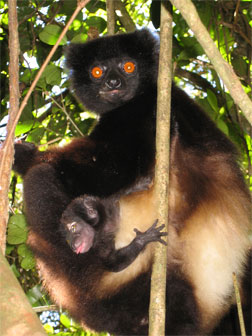Climate Change Threatens Lemurs
Climate Change Threatens Lemurs
Earthwatch Institute
September 18, 2006
Tropical rainforests are among the most stable environments on Earth, but they are still no match for global climate change. Dr. Patricia Wright, the widely admired primatologist and Professor of Anthropology at Stony Brook University, finds that climate change could mean the difference between survival and extinction for endangered lemurs.
Wright, the principal investigator of Earthwatch-supported research in Ranomafana National Park, Madagascar, will present her findings at a public meeting of the Explorer’s Club in New York on September 18. Her talk, titled “Long Term Research in Madagascar: Linking Lemurs with Climate Change,” summarizes more than 20 years of research at Ranomafana, home of four critically endangered lemur species.
“What we see in Madagascar is a window into the future of many other tropical ecosystems,” said Wright. “A slight change in climate, even in the rainforest where we assume there is plenty of water, can impact infant survival for lemurs. The conservation implications are immense.”

|
A paper published by Wright and colleagues in the Proceedings of the National Academy of Sciences in November 2005 demonstrates how even subtle changes in climate directly result in lower reproductive success in a species of lemurs known as Milne-Edward’s sifakas. In drier years, older females were unable to produce the milk their infants needed, leading to higher infant mortality.
“With deforestation and habitat fragmentation increasing daily in the region, as well as global climate change, the immediate effects are the drying out of habitats like the rainforest of Ranomafana National Park,” said Wright. “I was shocked to see the effect of rainfall decreases of such small magnitude on the survival of infant sifakas. The implications are huge in a world full of endangered species.”
Wright’s long-term study at Ranomafana also shows a decline in the population of the greater bamboo lemur, a lemur that specializes in eating bamboo plants found near rivers. This critically endangered species may be down to less than 100 individuals, making it very vulnerable to extinction from habitat changes.
For over a decade, Dr. Wright’s work has been supported by Earthwatch volunteers, ordinary citizens who work alongside scientists to address the world’s most pressing environmental problems. “Earthwatch volunteers come here from all over the world,” said Wright, ” and that sends a very important message to the local people here. What they have is so special and so valuable that people will travel far and pay money to see what’s in their backyard.”
In 1986, after Wright and colleagues discovered a new species of lemur, the golden bamboo lemur, she spearheaded the establishment of Ranomafana National Park and launched a community conservation program there. “Pat has a conscience you don’t always see in science,” says former student and Earthwatch principal investigator Luke Dollar of Duke University. “She doesn’t just gather her data and leave. Pat takes it upon herself to integrate the local community into her programs and to collaborate with them toward a common goal: conservation of their environment.”
Dr. Wright received the distinguished MacArthur “Genius” Fellowship and two medals of honor from the government of Madagascar for her conservation efforts in the region. Her accomplishments were featured in the award-winning PBS documentary “Me and Isaac Newton,” on NPR and BBC radio, as well as in The New York Times, Newsday, USA Today, The Wall Street Journal, and an April cover story in Smithsonian magazine.
Earthwatch Institute is a global volunteer organization that supports scientific field research by offering members of the public unique opportunities to work alongside leading field scientists and researchers. Earthwatch’s mission is to engage people worldwide in scientific field research and education to promote the understanding and action necessary for a sustainable environment. The year 2006 marks Earthwatch’s 35th anniversary. For more information on Dr. Wright’s ongoing research in Madagascar see http://www.earthwatch.org.
The September 18 lecture is open to the public. No advance reservations. Tickets are sold at the door on a first come, first served basis, beginning at 6pm. Ticket price: $15; Students: $5.
This is a modified news release from the Earthwatch Institute.